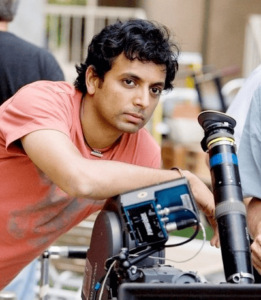The key grip is the person who runs the grip crew during the production of a film or television series. These men and women are chiefly responsible for positioning a production’s cameras and support equipment. They also oversee the people who position this equipment.
Grip Crew Members
The grip crew is the team responsible for a production’s cameras and the support equipment which elevates film equipment, including the lights and cameras. Rigging, cranes, and dollies are some of the support equipment the grip crew manages. A grip crew features a key grip, the best boy who assists the key grip, and other grips. Some of these grips have specialized roles, such as rigging grip.
Where Does the Name “Key Grip” Come From?
The term “grip” dates back to the days of traveling circuses. Some suggest the word was a slang name for a tool bag, something key grips need on set today. Others suggest that grip was a sailing term adopted by the many former sailors who moved to film work. While the exact origins aren’t clear, the theories are certainly interesting.
Differences in the Job Role of Key Grips
The term key grip means different things in different countries. The definition above is valid for the United States. However, in the United Kingdom, key grips only work with cameras. In Australia and New Zealand, a key grip owns all the grip equipment and tools.
Grip vs. Gaffer
The roles of a grip, including a key grip, and a gaffer are often confused. However, the gaffer is the only person who touches the lighting. When key grips deal with lighting, they are not touching the lighting itself. They set up skeletons and rigs for the gaffer to hang their lights. They then cut and shape the lighting the gaffer set up using flags and other tools, but they do not set up the lighting.
What Does a Key Grip Do?
Key grips have a range of responsibilities. Their common tasks include:
- Scouting locations to determine their suitability for filming
- Discussing lighting and camera requirements with cinematographers and ensuring they are met
- Setting up production cameras
- Watching the first run-through of a scene to determine how to frame it
- Cutting and shaping lights set up by the lighting department
- Monitoring the set and ensuring filming runs smoothly
- Keeping the cast and crew safe
- Reviewing production equipment orders
- Hiring the production crew
Key Tools Needed in a Key Grip Job
A variety of tools help key grips complete their work to a high standard. Familiarity with the following tools can help key grips work efficiently:
- C-wrench
- Gerber suspension multi-plier
- Speed wrench
- Knife
- Screwdriver
- Measuring tape
- Foot level
What Skills Do You Need to Work as a Key Grip?
Working as a key grip calls for a variety of different skills. Along with relevant experience, studios look for key grips with the following qualities:
- Creativity: Key grips use their creativity to imagine how their setup will give directors the footage they want.
- Technical knowledge: Key grips understand how different equipment impacts the footage captured. Along with understanding lighting, they also understand how shadows fall and how this will affect the shot, for example.
- Problem-solving skills: When equipment fails, key grips use their problem-solving skills to find solutions that minimize delays.
- Communication skills: Key grips use their communication skills to tell their department how to set up equipment in the best way for each shot. Their listening skills also help them understand the cinematographer’s vision.
- Physical fitness: Carrying and setting up heavy equipment and stands is very physically demanding.
Personality
Certain personality traits make key grips more likely to succeed. Key grips typically have the following qualities:
- Collaboration: Key grips work closely with other production crew members, so they must enjoy working as a team and be receptive to new ideas.
- Positivity: Some parts of a key grip’s job are tedious, like dismantling equipment. However, a positive attitude can motivate others and make sure these tasks aren’t a drudge.
- Patience: Key grips need the patience to handle the demands of their job and deal with any setbacks.
Education & Training for Key Grips, a Specialized Job
Working as a key grip does not require a degree. However, attending film school can help key grips learn about the production process.
On-the-job training deepens this understanding and teaches aspiring key grips essential gripping skills. Aspiring key grips can learn skills before landing their first production role by interning for a key grip or working for a production equipment rental house. Taking an entry-level grip role helps aspiring key grips build their knowledge.
Getting Started With Employment & Advancement
Key grips have extensive production experience. Their experience in different production roles gives them a clear understanding of their team’s roles. A common career path for key grips is:
- Grip
- Dolly grip
- Best boy grip
- Rigging grip
Aspiring key grips tend to work their way up the career ladder by forging strong relationships with their crew. While working their way up the ranks, people should note what their key grips do. Key grips can teach their crew members technical skills and how to be a good leader.
How to Make a Living as a Key Grip
After securing a key grip job, the next challenge becomes finding your next position. The following tips can help key grips make a living:
- Monitor job boards for vacant key grip positions
- Reach out to industry contacts
- Consider joining the union
What to Expect from the Key Grip Lifestyle
Key grips usually work on a freelance basis. They are employed for a certain project and must look for more work after each one finishes. The relationships they make during production often help them find future roles.
Working on a feature film can take months, while working on an advertisement takes days. The variety of different jobs available for this role ensures that key grips can set their own lifestyle and achieve a good work-life balance. As an integral crew member, key grips usually work 10 to 12-hour days during productions.
How Much Does a Key Grip make?
Key grips usually earn around $59,000 a year. Average salaries range from $41,000 for new key grips to $131,000 for more experienced professionals.
Joining the union can help key grips earn more. The pay of union members is set according to a pay scale based on each project. They can also expect overtime pay if their projects run long.
Unions, Groups & Associations
IATSE Local 80, commonly called the Grip Union, is the union for key grips and other grip crew members in the United States. The Grip Union offers classes that can help its members in their careers.
There are also several online resources that can help key grips learn more about their craft and feel connected to their industry. These sources include:
Tips to Prepare for Meetings
As a department head, key grips often meet with other important members of the production crew. The following preparation tips can help key grips get the most from these meetings:
- Read the script before the meeting. Make notes and highlight issues or questions.
- Watch the cinematographer’s look references.
- Ask to attend discussions between the director and cinematographer to learn about their creative visions.
- Discuss grip support and camera movement with the cinematographer.
- Discuss lighting and gearing up on set with the gaffer and cinematographer.
- Attend all production meetings so you know what the entire crew is thinking.
- Request expendables, tools, and equipment you need for the project.
Becoming a key grip takes time, but building strong connections and gaining experience can help grip professionals rise to the top of their departments.
















